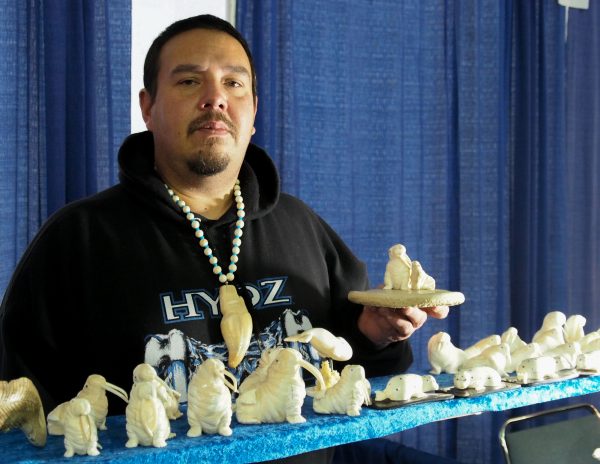Ivory bans in contiguous U.S. hit Alaska Native carvers hard

Recent measures to curb elephant poaching in Africa are having unintended consequences in Alaska.
This July, the U.S. Fish and Wildlife Service’s near-total ban on the commercial ivory trade went into effect. At about the same time, state-level bans passed in California, Hawaii, New Jersey and New York, after targeted lobbying efforts from conservation groups.
These regulatory changes are starting to bite into Alaska’s ivory market, made up primarily of walrus, mammoth and fossilized ivory, even though none of those are illegal. According to hunters, artists, and regional leaders, it’s expected to get worse.
Walrus carvings
Inside the craft fair during the Alaska Federation of Natives convention in Fairbanks last month, the glitter and gleam of Dennis Pungowiyi’s ivory stood out. His table was crowded with everything from small, intricate sculptures of birds to an ornate full mount and curved cribbage boards etched into tusks.
But Pungowiyi is best known for his carvings of walruses, where the angular rendering of the hides hints at an abstract interpretation.
“These bigger ones are from a 10 pound tusk, and I only get two or three of those tusks a year,” Pungowiyi said. At the bottom of his necklace hung the fist-sized tooth of a killer whale with a polar bear’s head carved into the top.
Walruses are not an endangered species, and Alaska Natives are allowed to carve and sell their ivory under provisions in the Marine Mammal Protection Act.
Way of life
Pungowiyi’s family is from Savoonga, which, along with Gambell on St. Lawrence Island, accounts for the vast majority of walruses harvested each year in Alaska. Since 2012, hunters from St. Lawrence Island have harvested anywhere from 433 to 1,206 walruses in a year, according to tagging statistics provided by the Fish and Wildlife Service.
The primary reason for the hunt is food, but the sale of tusks and carvings helps bring in cash.
“We’ve taken a pretty big hit on this elephant ivory ban,” Pungowiyi explained, adding that potential buyers have begun to conflate elephant and walrus ivory.
Pungowiyi lives in Wasilla most of the year, in part to have better access to the ivory market on the road system. But his livelihood still depends on regular trips to Savoonga each spring to hunt and buy raw tusks.
Since the summer, federal and state regulations cracking down on the domestic market for elephant ivory have caused people to think all ivory is illegal.
“I’m down probably a good 40 percent,” Pungowiyi said. “This show here is what I’m banking on getting me through the winter.”
At some of the other tables, sellers said they’ve heard of the bans, but haven’t seen an impact yet. Pungowiyi thinks that’ll change this year when ivory buyers go out to villages.
Alarm bells are already sounding.
Impact on Indigenous Peoples
During AFN, U.S. Senator Dan Sullivan convened an official field hearing to assess what can be done.
“While perhaps well intentioned, these state bans have had the unintended consequences of limiting the ability to trade in authentic articles of Native handicrafts, and in other cases they have created confusion,” Sullivan said.
Regional leaders testified at the hearing that not only are they seeing ivory prices drop, but there’s been an uptick in unlawful confiscations by federal agents.
Melanie Bahnke is president of Kawerak, the regional nonprofit for the Bering Strait Region. Like Pungowiyi, she is from Savoonga and has siblings whose carvings help pay for clothing, heating oil, and essential goods.
Earlier this summer, Kawerak flew in carvers from around the region for a craft fair in Nome to greet wealthy tourists when the Crystal Serenity cruise ship docked. But it was a bust.
“Once they realized something was made out of ivory, you could tell that there was almost disdain,” Bahnke said in an interview during AFN.
Reliant on outside commerce
Alaska has a robust internal market for walrus ivory, where subsistence hunting is not controversial and the use of marine mammal products is common.
But carvers are reliant on commerce with outside states. Even though California and New York are far away, the drop in demand means Alaska ivory isn’t making it to market, an effect Bahnke and others worry could be devastating to rural communities like Savoonga.
“It can be a huge part of a family’s income,” Bahnke said. “Whether it’s an $80 carving or $8,000, when our communities are already living below poverty that’s a big source of income for our people.”
To conservationists, however, the demand for ivory that has funneled cash from tourists, merchants, and galleries back to Alaskans is the same one threatening to wipe out elephants in Africa.
“We’re talking about the survival of a species,” said Elly Pepper with the Natural Resources Defense Council.
“Given the current poaching crisis, we’re trying to close as many loopholes as we can to get the situation under control,” Pepper said, speaking from her home in Maine.
Nuances ‘may have been lost’
NRDC is one of the national conservation groups that has lobbied state legislatures on ivory bills. They focused on California, Hawaii, and New York because they are the states that play the biggest role in illegal wildlife trafficking.
In the last decade, elephant poaching has reached unprecedented levels, driven by surging demand from China, Pepper said. While the U.S. has long outlawed sales of “new” elephant ivory, there were enough allowances to fuel a black market.
“The U.S. has historically allowed the sale of old or antique elephant ivory. That created a huge loophole that lead to a parallel illegal market, because it’s very difficult to distinguish ivory date,” Pepper said.
The four state bans that have passed do technically include exemptions for walrus ivory harvested by Alaska Natives. But Pepper concedes that in the rush to deglamorize ivory overall, those nuances may have been lost.
“I think most people have tried to make it pretty specific to elephant ivory, but I think maybe the messaging has been conflated,” Pepper said.
Alaskans have few options for recourse over bans passed in other states. Subsistence advocates are recommending language in state bills that more explicitly acknowledges the rights of Alaska Natives, along with a public relations campaign highlighting the sustainable nature of walrus ivory.
Related stories from around the North:
Canada: Canadian Inuit blast ruling on continued EU seal ban as ‘morally reprehensible’, Eye on the Arctic
Denmark: Reinstilling pride in the Inuit seal hunt, Eye on the Arctic
Finland: Utsjoki residents at odds over Tenojoki salmon fishing restrictions, Yle News
Greenland: What the EU seal ban has meant for Inuit communities in the Arctic, Eye on the Arctic
Iceland: Feature Interview – Hunting culture under stress in Arctic, Eye on the Arctic
Russia: Russia declares another indigenous group ‘foreign agent’, The Independent Barents Observer
Sweden: European sealskin ban affects Sámi handicraft workers, Radio Sweden
United States:When Alaska fishing village residents can’t fish, normal life comes to an end, Alaska Dispatch



